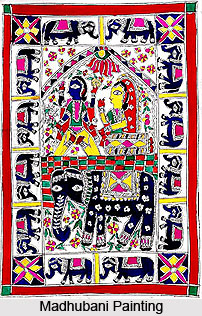 The state of Bihar is rich in its arts and crafts. The state is the origin of India"s first paintings that include the famous Madhubani painting and the miniature painting done on paper and leaves. It is also well-known for wall decorations, patchwork, applique work and local handicrafts. Bihar is also famous for stone pottery, white metal statuettes, bamboo artifacts, wooden toys and leather goods. Wood inlay is another ancient craft quite famous here. In north Bihar, a special grass called Sikki is found which when dyed in bright colours and woven with the natural grass makes excellent attractive baskets, boxes and figures.
The state of Bihar is rich in its arts and crafts. The state is the origin of India"s first paintings that include the famous Madhubani painting and the miniature painting done on paper and leaves. It is also well-known for wall decorations, patchwork, applique work and local handicrafts. Bihar is also famous for stone pottery, white metal statuettes, bamboo artifacts, wooden toys and leather goods. Wood inlay is another ancient craft quite famous here. In north Bihar, a special grass called Sikki is found which when dyed in bright colours and woven with the natural grass makes excellent attractive baskets, boxes and figures.
History of Crafts of Bihar
Crafts of Bihar reflect the culture of different successive empires. Mithila, a region situated to the north of Bihar, is the place where the Madhubani paintings are believed to have originated centuries ago. These paintings form the unique folk art done on either paper or canvas by tribal women. Bihar had a rich history of clay pottery work. Since the time of Mauryan and Gupta this art has been in practice in Bihar. The archeological excavations at places like Nalanda and Rajgir had confirmed the existence of this artistic craft in Bihar.
Sujini craft
The first thing, which comes to mind when speaking of crafts of Bihar is the Sujini, which are traditional, quilts made in Bihar. The embroidery on the quilt is done in running stitch in a scale pattern, which depicts village scenes such as peacocks dancing, boys flying kite etc.
Appliqué work
The appliqué work of Bihar is called Khatwa, which is used in decorative tents, canopies, shamianas etc. The appliqué designs for tents are Persian type trees, flowers, animals, and birds.
Paintings in Bihar
Painting in Bihar has been unique and is known as Madhubani art. It is an exquisite cave painting, which defines itself in symbolic motifs such as Durga, Radha, Krishna, Shiva and Parvati. The colours used in the paintings are vibrant red, yellow and green to ochre, brown and black. Local artists of Madhubani village on walls do the paintings on paper and cloths.
Wood carving
One of the ancient crafts of Bihar is the wood inlay. The inlays are done with different materials like metal, ivory and stag horn. Marvellous pieces of trays, boxes and other articles for households are produced using this craft. It is a very colourful craft.
Lac craft
Lac has been used in Bihar for centuries, and lacquer ware is a traditional craft of the state. One of the ancient items is the round conical box in which the bride`s parents present her with a nose ring at the time of marriage which has interesting symbols of fertility and longevity inscribed on its red body. The other colourful and ornamental articles are chapatti boxes and dry fruit containers.
Stone craft
Stone craft of Bihar is evident from the ancient sculptures of the Mauryan period. The notable stoneware place in Bihar is Patharkatti in Gaya district. Chandil and Karaikalla in Singhbum district and Dumka in Santhal parganas work on magnificently grained greenish black soapstone.
Glass craft
The glasswork of Bihar is a popular craft, which is exported abroad. This craft has gone down with time. Traditional pictures made on the walls of the houses are highly decorative and attractive which are made of glass with gold or silver pieces to fill up the entire picture. A number of articles are made this way are boxes, trays, table tops and mats. Tikuli is another form of craft made from broken glass. The craftsmen first melt the broken glass and then give is shape and design.
Textile craft
In Bihar, the printed textiles are a good example of craft and it is usually done on cotton, wool and silk. Bhagalpur, Bihar Sharif, Darbhanga, Saran and Patna are famous for this craft. There is a printing sector in North Bihar where only mica (khari) printing is done.
Carpet weaving
The tradition of carpet making in Bihar dates back to the Buddhist and the Mauryan period. Though this craft is on the decline it continues to produce the old designs based on the Indo-Persian style.
Pottery
Pottery is a form of clay craft that traces its origin since the ancient dynastic rules in the region. Earlier it was made in the form of daily utensils has now found its way as decorative art with colourful painting being made on earthen pots. Patna is famous for such work.
Sikki craft
Sikki is a grass or a weed thrived on most of the river bank. Sikki work is a craft where these unnecessary riverside weeds into beautiful decorative objects. This craft is particularly practiced by women artisan in Bihar. Beautiful toys and wares are manufactured out of this grass.
Embroidery craft
Artistic embroidery and Zari works is famous in Bihar and is also a livelihood for many families. Some of the finest Zari works can be found in shamiyanas, kanath, chandwas, pillow-covers, batwas, etc. Kasida embroidery is an ancient form of art. It is done with gold and silver metallic threads, beads, silk, and sequins on satin or velvet with motifs of birds, leaf, etc.



















